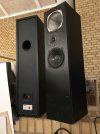Lord Victor
Active Member
- Joined
- Apr 19, 2019
- Messages
- 143
- Likes
- 99
Hey, I’m currently working on a university project where I’ll need to test the absorption ability (SAC) of various material samples.
I found this paper which is good, but it isn’t clear to me if I can do this without an audio analyzer? Or if there is another simpler way to get results good enough for my project (doesn’t need to be perfect).
I own a single UMIK and would need to buy a second one to build an impedance tube like the one in the paper - but I have no idea how to do the test even if I had the second mic - can REW do it somehow?
Or can I rest it with a single mic somehow? Please help.
This is for an industrial design project, so it will not need to be as perfect tests as for actual acoustic engineering papers etc (though it’d be nice), just good enough to indicate results.
I found this paper which is good, but it isn’t clear to me if I can do this without an audio analyzer? Or if there is another simpler way to get results good enough for my project (doesn’t need to be perfect).
I own a single UMIK and would need to buy a second one to build an impedance tube like the one in the paper - but I have no idea how to do the test even if I had the second mic - can REW do it somehow?
Or can I rest it with a single mic somehow? Please help.
This is for an industrial design project, so it will not need to be as perfect tests as for actual acoustic engineering papers etc (though it’d be nice), just good enough to indicate results.

